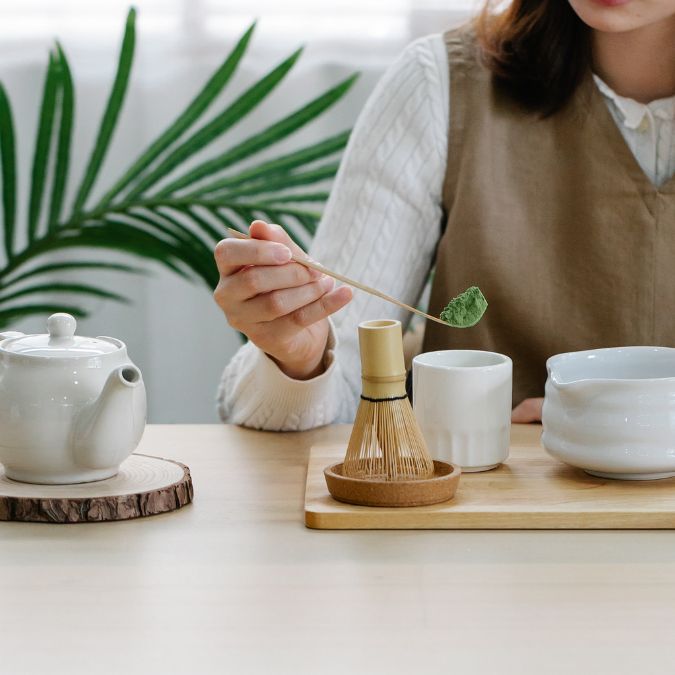When buying matcha tea , it is important that you take into account certain points to ensure that you obtain a quality product and enjoy all its benefits to the fullest. Here I present some useful guidelines for you to make the best choice.
Within this article, we will talk about the importance of checking the color and texture of the powder, knowing its origin (tea from China is not the same as that from Japan), paying attention to labeling and looking for certifications that support its origin and ethical production. These details will help you make a good decision when you make your purchase and you will avoid being deceived because, I can tell you in advance that, in any supermarket, they tend to give a pig for a poke.
As you know, I don't like this; I don't like anything, but nothing, cheating and, therefore, I want to shed some light so that you have all the necessary information.

Tips for choosing the best matcha tea
The quality of matcha tea largely depends on how it is grown, processed, and stored. To properly identify its grade of quality when buying it, there are several factors to take into account:
color and texture
The color and texture of matcha tea are vital characteristics in evaluating its quality. A high-quality, authentic matcha tea should have a bright, deep green color, reflecting the intense concentration of chlorophyll and amino acids present in the green tea leaves. This vibrant hue is a sign that the leaves were carefully grown in the shade during the last few weeks before harvest, enhancing their unique properties and flavors.
In addition to the color, the texture of the matcha tea is equally important. A high-quality powder should be fine and smooth, similar to the feel of talc. When running your fingers over the powder, a smooth, silky smoothness should be felt, indicating very meticulous processing and proper grinding of the leaves.
Conversely, a lower quality matcha tea is often duller in color and less intense, indicating that the leaves were not grown under optimal conditions or were not subjected to the proper shading process. This aspect can be due to less careful cultivation practices or even the use of lower quality leaves, which negatively affects the taste and benefits of matcha tea.
Texture can also be an indicator of quality. If your matcha tea has a coarse or grainy texture, it is likely that it has been improperly ground, which affects the uniformity of its particles and can negatively influence its flavor and ability to mix properly with water or milk during preparation. .
By looking at the color and texture of matcha tea when buying it, you can make a better decision and ensure that you are purchasing a high-quality product that meets your expectations in terms of taste, aroma, and health benefits. A matcha tea with an intense green hue and a fine and smooth texture will provide you with an incredible experience when drinking it, giving you the opportunity to fully enjoy this ancient and wonderful Japanese drink.
Scent
The aroma of matcha tea is a distinctive element that tells us a lot about its quality and freshness. A good quality tea should have a fresh, vegetal aroma, similar to freshly cut grass or green leaves. This characteristic fragrance is the result of the careful cultivation and processing of green tea leaves, which preserves its essential oils and volatile compounds that give it its unique and pleasant aroma.
The fresh, vegetal aroma comes from the amino acids and chlorophyll present in the leaves, especially L-theanine, which is responsible for its relaxing qualities and herbal notes. This aromatic profile is not only pleasant within the experience of drinking matcha tea, but it can also influence the sensations and emotions during its consumption, providing a feeling of calm and well-being.
On the other hand, cheaper or lower quality varieties may display an aroma that may even be unpleasant. This can be due to various factors such as improperly processed tea leaves, unfavorable cultivation conditions, or poor quality blends. In these cases, matcha tea can have off, bitter, or rancid odors, negatively affecting the tasting experience and diminishing the potential health benefits that authentic tea can offer.
When buying matcha tea, it is very important that you pay attention to the smell, since it is an important indicator of its quality. A fresh, vegetal aroma is often a sign of a high-quality, authentic tea. If the aroma is unpleasant or even astringent, it may not be authentic or may not have been grown and processed properly.

Origin
Knowing where the matcha tea you are buying comes from gives you valuable information about its quality and authenticity. Traditionally, it has been grown and produced in Japan, this country being the main producer and exporter of this wonderful drink.
Within Japan, there are regions famous for their tradition and expertise in the cultivation of matcha tea. Two of the most recognized are Uji and Nishio. Uji, located in the Kyoto prefecture, is one of the oldest and most prestigious areas for the production of this drink. Its climate and soil offer optimal conditions for growing green tea leaves, resulting in high-quality matcha tea with exceptional flavor and aroma.
For its part, Nishio, located in Aichi Prefecture, also has a rich history of tea production. This region is known for its focus on sustainable agriculture and for the cultivation of special varieties of green tea that are specifically intended for the preparation of matcha.
The teas produced in these regions have a great reputation for quality, and their producers strive to maintain standards of excellence at every step of the cultivation and production process. Shading techniques, careful harvesting of the leaves and traditional grinding methods combine to produce an exceptional matcha tea, appreciated by both connoisseurs and those seeking an authentic and wholesome experience.
It is important to note that although Japan is the main producer, today variants are also cultivated and produced in other parts of the world. However, if you want to make sure you get a high-quality, authentic-tasting matcha tea, opting for those that come from Japan is a wise choice.
Labeling and certifications
Labeling and certifications are crucial aspects to consider when buying matcha tea, as they provide essential information about the provenance, cultivation methods, and production practices used in making the product.
When looking for matcha tea, it is essential to look for those that have clear and detailed labels about their origin. Information about the country and region where it comes from will allow you to have a more precise idea of its quality and authenticity. As we mentioned earlier, matcha teas produced in Japan, especially in renowned areas like Uji or Nishio, are often highly valued for their excellence in growing and processing green tea leaves.
In addition to the origin, it is advisable to look for a tea that indicates the harvest date. Freshness is essential to fully enjoy its flavors and benefits. Knowing when it was harvested will allow you to ensure that you are acquiring a recent matcha tea and that it preserves all its qualities.
Another important consideration is the presence of organic or fair trade certifications on the label. A certified organic matcha tea guarantees that the tea leaves were grown without the use of pesticides, herbicides or other synthetic chemicals that could affect its quality and safety for consumption. Opting for an organic tea is not only beneficial for your health, but also for the environment, since it encourages sustainable and nature-friendly agricultural practices.
On the other hand, fair trade certification indicates that matcha tea has been produced under fair and ethical working conditions, ensuring that the workers involved in its cultivation receive a fair wage and have their labor rights guaranteed. Choosing a Fair Trade certified tea supports a responsible and conscientious supply chain, which contributes to improving the living conditions of farmers and their communities.
It is important to note that certifications, both organic and fair trade, are issued by independent organizations that test and certify that matcha tea meets the standards set forth in each category. These certifications are a reliable indicator of quality and production ethics.
And with this, we finish the first part of the guide. In the following article, we will address the different categories of matcha tea, its uses, and how to store it correctly so that it preserves all its properties.
Do not miss it!




Share: